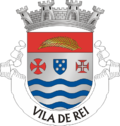- Royal standard of King John V of Portugal
- Flag of the Cisplatine Province
- Flag of a Governor-General of the Portuguese Empire
- Flag of a Governor of the Portuguese Empire
- Flag of a Province Governor of the Portuguese Empire
- Flag of an Intendent of the Portuguese Empire
- Flag of an Officer of the Portuguese Empire
- War flag of Portugal during the Portuguese Restoration War
- Insignia of the Order of the Colonial Empire
- Colonial coat of arms of Terceira Island
- Coat of arms of the Viriatos Portuguese Foreign Legion
- Flag of the Municipality of Portuguese Macau
- Variant used during the Discovery Age


The Cross of the Order of Christ (Portuguese : Cruz da Ordem de Cristo), also known as the Cross of Christ (Cruz de Cristo) or the Portuguese Cross (Cruz Portuguesa), is a cross symbol of Portugal, originating in the Portuguese Order of Christ, founded in 1319. During the time of Prince Henry the Navigator, the cross came to be associated with the Portuguese discoveries and the Portuguese Empire. The cross can be considered a variant of the cross pattée or the cross potent.















































